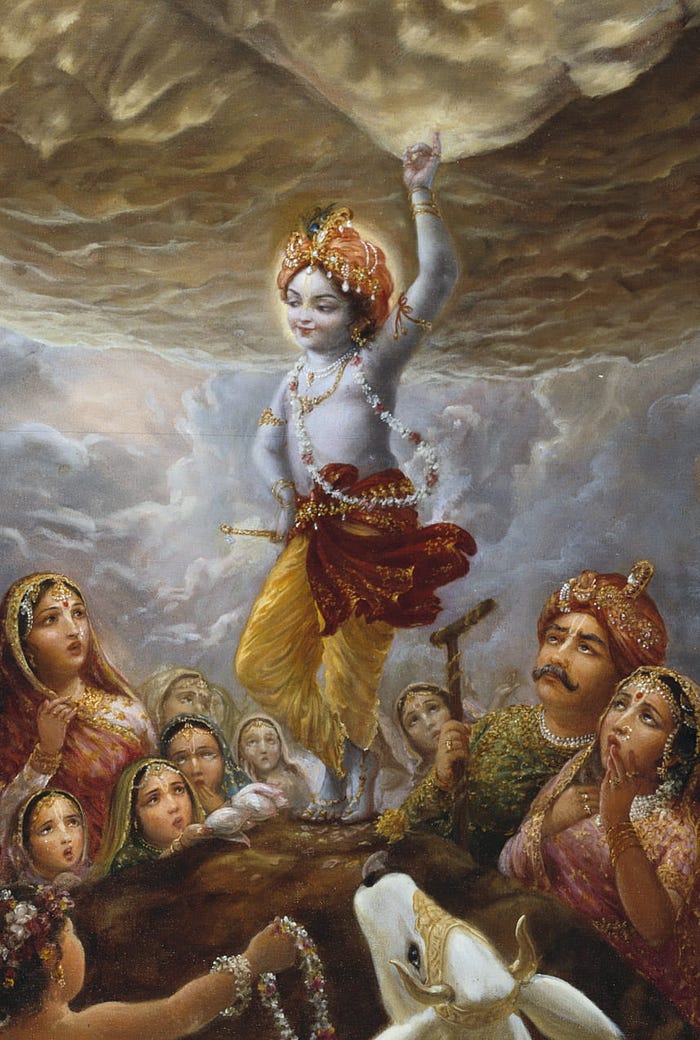Govardhan, located south of Delhi, is a quaint village that is a three-hour drive away. People often see it as a convenient spot for a quick snack break while en route to Mathura or Vrindavan. Surprisingly, though, Govardhan holds a significant position in Krishna folklore and amasses far more visitors than one expects.
According to belief, here, Lord Krishna raised Goverdhan Parvat (GP) on his finger to protect the kinsmen from the wrath of Indra, the rain god. Legend has it that when the people of Braj were distressed by heavy rains, Krishna advised them to worship GP instead of Indra. Enraged, Indra unleashed a storm, only for Krishna to shield everyone by lifting the mountain (GP) with his little finger like an umbrella. Under the mountain, the people found refuge and could defy hunger and thirst.

Govardhan, the once mystical mountain, has now diminished into a mere tiny hill, stretching for about 5 km. There is a 12 km pathway, encircling this hill, and then, a 9 km route has been introduced, which takes you through various local temples that tell charming Krishna-Radha stories. Completing the entire 21 km walk takes 5–6 hours for those with sturdy legs, or one can choose to ride an E Rickshaw and complete it in half the time.
The village attracts followers from all over the world. They come here to do the hill’s circumambulation, or the parikrama. During Holi week, Govardhan Puja, and Guru Purnima, the area experiences high crowds. In March 2024, during one such Hol(y/i) week, we took a rickshaw and witnessed the following scenes.
The routes were mishmash — dusty walking trails, paved roads, narrow footpaths littered with garbage, and even winding through quiet residential streets lined with houses. Holy chants filled the air as people of all ages and backgrounds walked barefoot. It was awe-inspiring to see devotees prostrating themselves with Sashtang Pranams, their every movement a testament to their faith. Occasionally, one could catch a glimpse of Bhandaras, community kitchens serving meals to anyone in need. The route meandered back and forth between the Mathura district in Uttar Pradesh and Bharatpur in Rajasthan, but in ancient times, people knew this entire region as Brij Bhoomi — the sacred land where the young Krishna danced. It was here that he triumphed over the demon Kansa, reveled in the company of milkmaids, and protected his Yadav tribe. Eventually, he moved to Dwarka in the latter part of his life.

The most logical rule for Parikrama is to begin and end at the same location. Other recommendations, such as walking the entire distance barefoot or taking a dip in holy ponds and tanks on the way, are optional.
In the summer, it’s scorching hot here, so people walk at 2–3 AM to finish before it gets intolerable. Taking holy dips in those (not so clean) ponds makes sense then.
The stops and the stories en route were as follows:
Govardhan Parbat
Despite being the highlight of this circuit, the mystical mountain didn’t leave a strong impression on me. It’s a small hill, 70–80 feet tall, and stretches for 5–6 kilometers. There’s a fence and a pathway encircling it. Inside, you can see Neel Gais, monkeys, and a few old temple ruins.

The walk begins and concludes at Dangati Mandir. This is the place where Krishna would collect ‘tax’ from the milkmaids by taking small portions of milk, butter, or yogurt that they carried with them.
Kusum sarovar
This stop on the route is important and stunning. The current building dates back to the late 17th century and was built by the Bundela rulers of Orchha. Later, the surrounding gardens were developed by Suraj Mal Jat, the ruler of nearby Bharatpur. The centerpiece of the stop is now his cenotaph, with a massive water body in front of it, measuring 450 feet in length and 60 feet in depth.

Kusum Sarovar, surrounded by a beautiful array of flowers and Kadamb trees, lives up to its name. Legend has it that Radha, while pretending to gather flowers for her friends, secretly met Krishna in this enchanting place.
Manasi Ganga mandir
The rulers of Amber built this temple — Raja Bhagwant Das made the enclosures and steps of the tank in 1637, and his son Raja Man Singh later embellished it.
According to folklore, Nand Baba and Yasoda, who were Lord Krishna’s foster parents, desired to bathe in the sacred waters of the Ganga river. In order to grant their wish, Lord Krishna meditated and brought the holy Ganga to the town of Govardhan. In another enchanting tale, Ganga beseeched her younger sister Yamuna to go with her and witness the joyful antics of Lord Krishna. Krishna, using his extraordinary mental abilities, fulfilled her request by bringing Ganga to Goverdhan, where he delighted her with his charisma and mischievous pranks.

Sankarshan Kund
As you continue the Govardhan Parikrama, the next destination is Sankarshan Kund, home to an ancient temple dedicated to Dauji, believed to be Balram, Krishna’s elder brother.
Punchri ka lotha
The parikrama now enters Rajasthan, in Deeg town. People believe that Poonchari’s Lotha was a close friend of Lord Shri Krishna. Everyone urges all devotees to visit this small temple. While the women went inside, menfolk skipped it.
Mukharbind Jatipura Mandir
The temple is located away from the main road. The pathway to the temple is full of shops selling religious souvenirs, lassi, and food items. According to belief, this is where Lord Krishna saved the brijvasi from heavy rain by lifting the Govardhan Parvat.

According to another later account, Lord Shri Krishna departed from Braj dham and proceeded to Nathdwara to fulfill other responsibilities. At the request of the Gopis and Brijwasis, he agreed to come and live here for a duration of six months — from Vasant Panchmi to Dassehra. Another story claims he commutes between the two temples daily — following the Sandhya Aarti at the Nathdwara temple, he proceeds to the Mukharvind Mandir to offer Shayan Darshans.
It was a kind of constant commute story in Orchha, with Ram doing his thing during the day and then heading back to Ayodhya at night. The Vedic gods had a lot on their plate.
Radha / Shyam Kund
There are two ponds named Radha and Shyam. It is recommended that you take a sacred bath in those ponds. As expected, hawkers, Brahmins, mendicants, and various types of commerce crowd the place.

The place has curious stories. Kans, Lord Krishna’s evil uncle, sent a demon called Arishta, disguised as a calf or bull, to harm him. Instead, Krishna and his brother Balram defeated and killed Arishta. But, killing a bull or cow is considered a sin, so Radha and religious pundits wanted him to make amends. So, Lord Krishna created a large water reservoir by striking the earth with his heel and purified himself in that sacred water. It is now known as the Krishna Kund.
Radha used her bracelet to excavate the nearby spot, creating the Radha Kund.
Afterthoughts
The Govardhan Parikrama is an experience for the believers. Skeptics seeking reason and evidence will feel frustrated, especially because of the traffic, noise, heat, and unpleasant smells in the area. That stubble of a hill tugs at the edge of credibility, and gotta admit, I wasn’t in the right mind space…having a hard time with the faith versus logic thing.
But then you witness devotees of all ages and genders, along with their families, in large numbers, prostrating themselves at every step of the way during the parikrama. I was told that this type of circumambulation could take anywhere from a couple of weeks to a month. This dedication and devotion caused the skeptic within me to pause and reflect. What motivates them to undertake such a grueling journey, with only a vague promise of salvation in the future, or an afterlife? Could it be blind faith, a steadfast trust in something greater, a personal mission, or simply a mundane hope for relief from their hardships and grievances? The physical challenges of the parikrama were clear, but the underlying triggers, motivations, and spiritual beliefs that drive it were not.

People who hold this belief assert that religious faith offers solace and a feeling of meaning. It transforms reality, inspires action, encourages resilience, and gives purpose in uncertain times. I wondered if calling it ‘the opium of the masses’ is not too glib, or downright lazy?
As I sulked, devotees walked by, cheering and chanting ‘Radhe Radhe.’ Where I saw commotion, they found salvation. It was in that moment of epiphany that I pondered if the Lord was attempting to convey a simple truth — though one may not alter reality, they can certainly alter their perspective.
Is it a valuable life lesson or just a placebo pill?
Although I didn’t necessarily agree with what I saw, I gained a newfound respect (and a hint of envy) for those who possessed faith.
